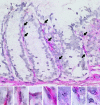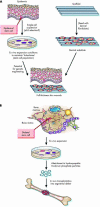The new stem cell biology: something for everyone
- PMID: 12665626
- PMCID: PMC1187299
- DOI: 10.1136/mp.56.2.86
The new stem cell biology: something for everyone
Abstract
The ability of multipotential adult stem cells to cross lineage boundaries (transdifferentiate) is currently causing heated debate in the scientific press. The proponents see adult stem cells as an attractive alternative to the use of embryonic stem cells in regenerative medicine (the treatment of diabetes, Parkinson's disease, etc). However, opponents have questioned the very existence of the process, claiming that cell fusion is responsible for the phenomenon. This review sets out to provide a critical evaluation of the current literature in the adult stem cell field.
Figures








References
-
- Thomson JA, Itskovitz-Eldor J, Shapiro SS, et al. Embryonic stem cell lines derived from human blastocysts. Science 1998;282:1145–7. - PubMed
-
- Lagasse E, Connors H, Al-Dhalimy M, et al. Purified hematopoietic stem cells can differentiate into hepatocytes in vivo. Nat Med 2000;6:1229–34. - PubMed
-
- Weissman IL. Translating stem and progenitor cell biology to the clinic: barriers and opportunities. Science 2000;287:1442–6. - PubMed
-
- Heslop HE, Rooney CM, Rill DR, et al. Use of gene marking in bone marrow transplantation. Cancer Detect Prev 1996;20:108–13. - PubMed
-
- Bonnet D. Haematopoietic stem cells 1. J Pathol 2002;197:430–40. - PubMed
Publication types
MeSH terms
LinkOut - more resources
Full Text Sources
Medical
